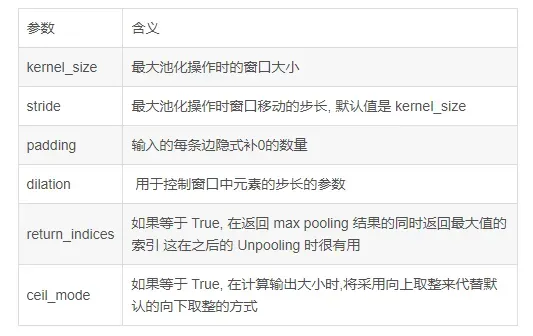1.卷积神经网络介绍
卷积神经网络(Convolutional Neural Networks, CNN)是一类包含卷积计算且具有深度结构的前馈神经网络(Feedforward Neural Networks),是深度学习(deep learning)的代表算法之一 。卷积神经网络具有表征学习(representation learning)能力,能够按其阶层结构对输入信息进行平移不变分类(shift-invariant classification),因此也被称为“平移不变人工神经网络(Shift-Invariant Artificial Neural Networks, SIANN)”
2.卷积神经网络架构
卷积神经网络主要包括卷积层,采样层(一般做最大池化)和全连接层(FC层)。

3.Pytorch实现卷积神经网络
- 卷积层:nn.Conv2d()
其参数如下:
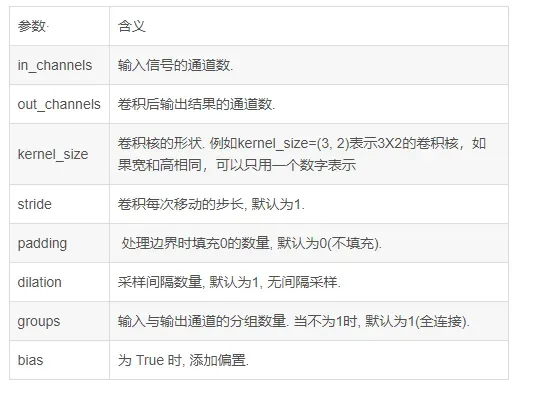
- 池化层:nn.MaxPool2d()
其参数如下:
4.实现MINST手写数字识别
一共定义了五层,其中两层卷积层,两层池化层,最后一层为FC层进行分类输出。其网络结构如下:
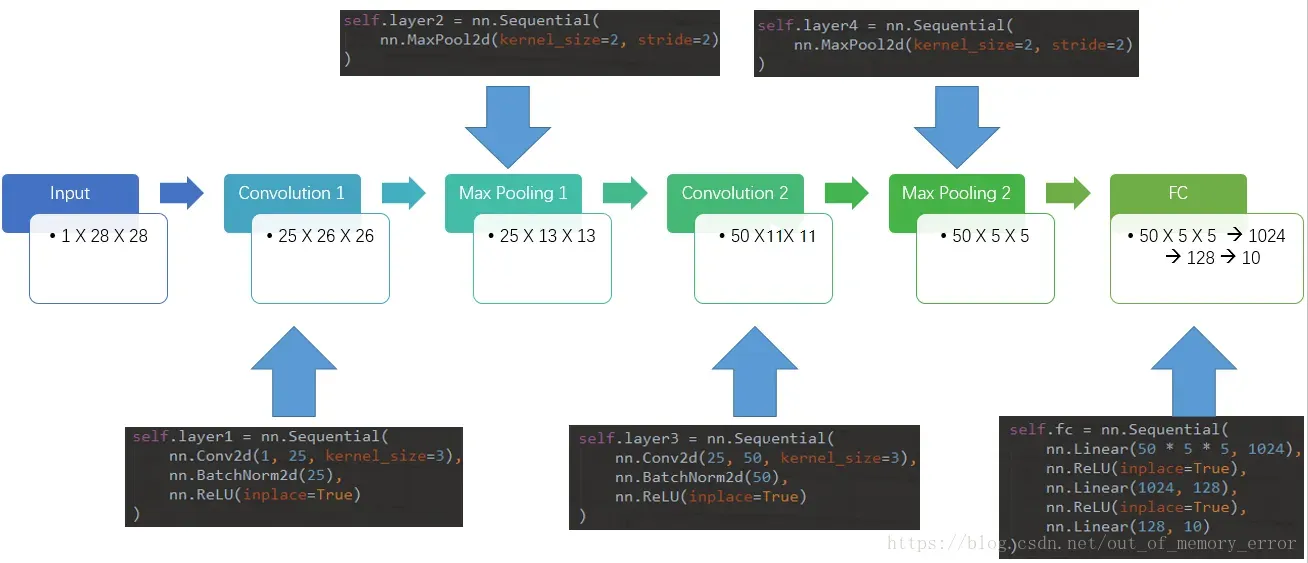
具体图片尺寸计算如下:
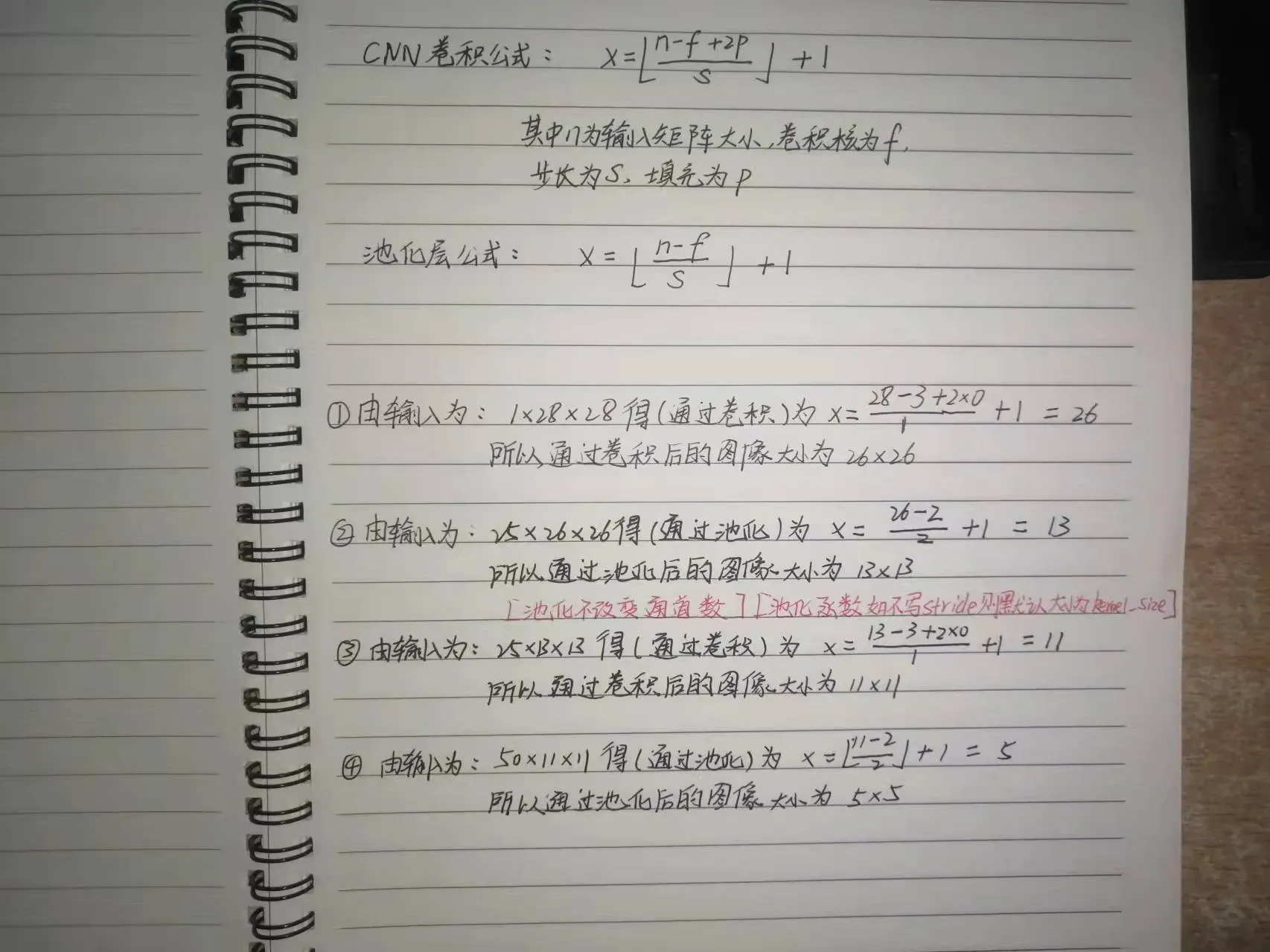
5.代码实现
import torch
from torchvision import transforms # 是一个常用的图片变换类
from torchvision import datasets
from torch.utils.data import DataLoader
import torch.nn.functional as F
batch_size = 64
transform = transforms.Compose(
[
transforms.ToTensor(), # 把数据转换成张量
transforms.Normalize((0.1307,), (0.3081,)) # 0.1307是均值,0.3081是标准差
]
)
train_dataset = datasets.MNIST(root='../dataset/mnist',
train=True,
download=True,
transform=transform)
train_loader = DataLoader(train_dataset,
shuffle=True,
batch_size=batch_size)
test_dataset = datasets.MNIST(root='../dataset/mnist',
train=False,
download=True,
transform=transform)
test_loader = DataLoader(test_dataset,
shuffle=True,
batch_size=batch_size)
class CNN(torch.nn.Module):
def __init__(self):
super(CNN, self).__init__()
self.layer1 = torch.nn.Sequential(
torch.nn.Conv2d(1, 25, kernel_size=3),
torch.nn.BatchNorm2d(25),
torch.nn.ReLU(inplace=True)
)
self.layer2 = torch.nn.Sequential(
torch.nn.MaxPool2d(kernel_size=2, stride=2)
)
self.layer3 = torch.nn.Sequential(
torch.nn.Conv2d(25, 50, kernel_size=3),
torch.nn.BatchNorm2d(50),
torch.nn.ReLU(inplace=True)
)
self.layer4 = torch.nn.Sequential(
torch.nn.MaxPool2d(kernel_size=2, stride=2)
)
self.fc = torch.nn.Sequential(
torch.nn.Linear(50 * 5 * 5, 1024),
torch.nn.ReLU(inplace=True),
torch.nn.Linear(1024, 128),
torch.nn.ReLU(inplace=True),
torch.nn.Linear(128, 10)
)
def forward(self, x):
x = self.layer1(x)
x = self.layer2(x)
x = self.layer3(x)
x = self.layer4(x)
x = x.view(x.size(0), -1) # 在进入全连接层之前需要把数据拉直Flatten
x = self.fc(x)
return x
model = CNN()
# 下面两行代码主要是如果有GPU那么就使用GPU跑代码,否则就使用cpu。cuda:0表示第1块显卡
device = torch.device("cuda:0" if torch.cuda.is_available() else "cpu") # 将数据放在GPU上跑所需要的代码
model.to(device) # 将数据放在GPU上跑所需要的代码
criterion = torch.nn.CrossEntropyLoss() # 使用交叉熵损失
optimizer = torch.optim.SGD(model.parameters(), lr=0.1, momentum=0.5) # momentum表示冲量,冲出局部最小
def train(epochs):
running_loss = 0.0
for batch_idx, data in enumerate(train_loader, 0):
inputs, target = data
inputs, target = inputs.to(device), target.to(device) # 将数据放在GPU上跑所需要的代码
optimizer.zero_grad()
# 前馈+反馈+更新
outputs = model(inputs)
loss = criterion(outputs, target)
loss.backward()
optimizer.step()
running_loss += loss.item()
if batch_idx % 300 == 299: # 不让他每一次小的迭代就输出,而是300次小迭代再输出一次
print('[%d,%5d] loss:%.3f' % (epoch + 1, batch_idx + 1, running_loss / 300))
running_loss = 0.0
torch.save(model, 'model_{}.pth'.format(epochs))
def test():
correct = 0
total = 0
with torch.no_grad(): # 下面的代码就不会再计算梯度
for data in test_loader:
inputs, target = data
inputs, target = inputs.to(device), target.to(device) # 将数据放在GPU上跑所需要的代码
outputs = model(inputs)
_, predicted = torch.max(outputs.data, dim=1) # _为每一行的最大值,predicted表示每一行最大值的下标
total += target.size(0)
correct += (predicted == target).sum().item()
print('Accuracy on test set:%d %%' % (100 * correct / total))
if __name__ == '__main__':
for epoch in range(10):
train(epoch)
test()
6.结果
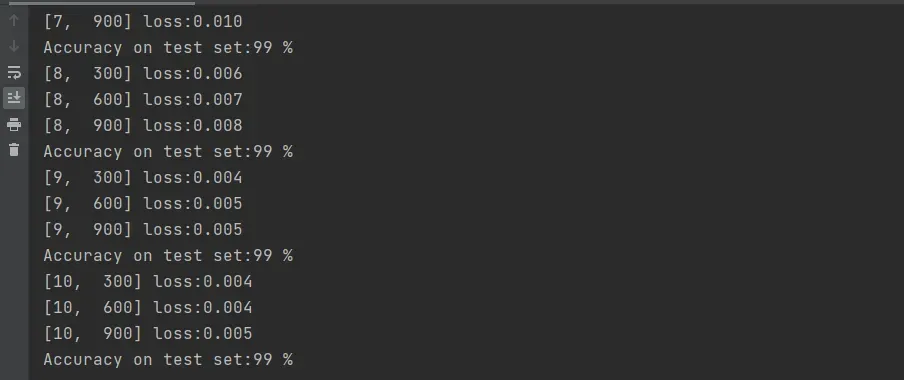
版权声明:本文为博主爱玩电动的阿伟原创文章,版权归属原作者,如果侵权,请联系我们删除!
原文链接:https://blog.csdn.net/weixin_41477928/article/details/123385000

